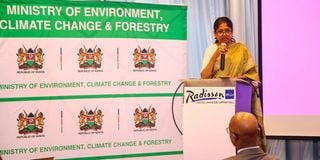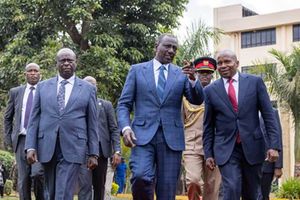New Tool Unveils Climate Risks for Kenya’s Children

What you need to know:
- At COP27, children and youth were mentioned for the first time in a final draft of a climate conference under the Sharm el-Sheikh Implementation Plan, with seven and eleven mentions, respectively.
- However, despite this acknowledgement, they were only given observer roles and did not have a seat at the negotiating table.
When 17-year-old Imran Hassan journeyed nearly 400 kilometres from his home in Garissa County to Nairobi for the inaugural Africa Climate Summit in September last year, he brought stories of climate-induced despair.
He was joining other children from across Africa, each carrying their own stories. Their narrations came in the form of first-hand experiences of climate disasters they had witnessed. Crammed in one of Nairobi’s ornate hotels, children representatives, like Imran, took to the podium to speak on behalf of Africa’s children.
It was a first. A needful first. For years, children’s voices have been stifled in the climate change discourse, and it was only until the 27th Conference of Parties (COP27) that the world’s premier climate summit featured its first pavilion dedicated to Children and Youth.
Attending the summit meant him skipping school for a few days, and his consolation was that the journey to the city would shine a light on issues affecting the children from Garissa; one of the counties of the Arid and Semi-Arid Lands (ASALs).
This was only a month after the world recorded the hottest day in 2023 on July 22.
“In my family, we have lost all our cattle and we have nothing left. We are on the verge of migrating, and this means that some students will miss out on studies,” Imran told Climate Action. “As children living in such dry areas, we hope that one day we will wake up and find the environment is green, just like in Nairobi. That will make us happy,” he said.
Even as Imran lived in a county that experienced the worst impacts of climate change, such as frequent droughts and floods, he did not understand that erratic weather patterns could be linked to climate change.
When he was 12 years old for instance, it did not rain in his home county until he turned 17. This happened when Kenya experienced the worst drought in four decades between 2020 and 2023. “It is the school that expanded my knowledge about climate change, and now, I have to spread awareness about it to my classmates,” he said. “Our school is a national school and some students keep transferring because of climate impacts,” he added.
While Imran went back to Garissa with his hope quashed after failing to talk to the President, he said that there is still a chance to remind leaders that what is done today for the planet will determine what happens in future. The sixth Assessment Report of the Intergovernmental Panel on Climate Change (IPCC) shows that the children born in this generation and those to come in future are more likely to be exposed to climate change impacts.
Yet, until August this year, Kenya did not have a children-specific data source on how climate change affects them. A new interactive tool called the Children’s Climate and Disaster Risk Model (CCDRM), launched by Unicef in collaboration with the Ministry of Environment has datasets that will now help different policymakers to understand the climate and disaster risk levels faced by children and their communities at the county level.
Their analysis shows that close to 12 million children in Kenya face climate and disaster risks from moderate to high-risk levels. Those from seven counties of Turkana, Samburu, Marsabit, Wajir, Mandera, Tana River, and Garissa are categorised in the “very high” level of risk category. About 2.4 million children reside in these counties facing very high-risk levels of climate and disasters.
While launching the tool, Shaheen Nilofer, a representative of Unicef Kenya, said that children are less capable of coping with extreme weather conditions, and climate change exacerbates it. “The climate crisis is a child rights crisis, and the CCDRM reveals the varying risk levels in each county, highlighting the urgent need for targeted action. This model is a vital tool for stakeholders to prioritise investment in climate action and disaster risk reduction efforts, building long-term resilience and sustainability for children and communities,” she said.
The tool analysed about 53 indicators related to climate change, including water scarcity, education, child nutrition, water sanitation and hygiene scores among others. “The CCDRM is a powerful example of how national stakeholders can work together to create decision-making tools in climate change adaptation and disaster risk reduction with a strong focus on children and their communities,” said Environment and Climate Change Permanent Secretary, Festus Ng’eno.
He added that the tool will support the unpacking and implementation of the National Climate Change Action Plan III (2023 to 2027) to help stakeholders target interventions and ensure that all children in Kenya have an equal and fair opportunity to reach their full potential. An analysis by UNICEF of about 591 project proposals on child-centred climate change initiatives, conducted between 2006 and 2023, reveals that despite the alarming statistics, less than 2.4 per cent of global climate financing is allocated to interventions specifically targeting children.
“Where children are considered, they are generally addressed as a vulnerable group rather than as active stakeholders or agents of change. Furthermore, projects rarely address the heightened risks and challenges faced by particular groups of children that experience intersecting forms of discrimination and inequality,” offers the report.
Data from Save the Children, a non-governmental organisation shows that more than 180, 000 children in just 2022 alone were displaced from their homes because of climate-related shocks. This was nine times more than the number displaced in 2021.
It is at COP27 that children and youth were for the first time mentioned seven and 11 times respectively in a final draft of a climate conference under the Sharm el-Sheikh Implementation Plan. Still, they got an observer role and no chance to be at the negotiating table.
At COP27, children and youth were mentioned for the first time in a final draft of a climate conference under the Sharm el-Sheikh Implementation Plan, with seven and eleven mentions, respectively. However, despite this acknowledgement, they were only given observer roles and did not have a seat at the negotiating table.
Another report released by UNICEF dubbed The Climate Changed Child explicitly says that; “Children are not like little adults; their smaller and less-developed bodies and minds are uniquely vulnerable to pollution, deadly diseases and extreme weather.”
The report showed that globally, nearly all children are already exposed to at least one major climate risk, shock or stress and about half of those (1 billion children) live in countries at extremely high risk.
Some of the major impacts that children are likely to face include; migration and displacement, mental health, different diseases from heat waves, air pollution and those related to nutrition.
As countries continue to develop, the report shows that they should have children in mind so that their future will not be compromised. At COP28, for the first time, delegates agreed to transition away from fossil fuels such as coal, oil and gas. At the same time, there was a unanimous goal to triple renewable energy by the year 2030.
“Decarbonisation and emissions reduction could lead to reductions in childhood asthma and adverse birth outcomes such as low birth weight. The transition to a low-carbon economy also carries the potential for children and young people to develop new skills and gain new employment opportunities in a new and growing labour market for clean energy and sustainability,” shows the UNICEF report.
With the evidence in place from studies that children are largely affected by climate change, global climate finance mechanisms leave them out. At the moment, children get about 2.4 per cent of climate finance mostly from multilateral climate funds (MCFs) support.
“When children are considered, they are treated as vulnerable victims rather than potential agents of climate action. Across all MCFs, just 1 per cent is the involvement of children as part of the design or monitoring of the project,” shows the report.
All hope is however not lost, as countries have started to embrace children by including them in their Nationally Determined Contributions (NDCs) towards climate change set under the Paris Agreement.
The analysis shows that 65 per cent of new and updated NDCs as at 2022 refer to children and young people compared to only 32 per cent of first or previously submitted NDCs.
Of this number, only 34 per cent of NDCs identify children as a vulnerable group and only 11 per cent identify children as drivers of change.




